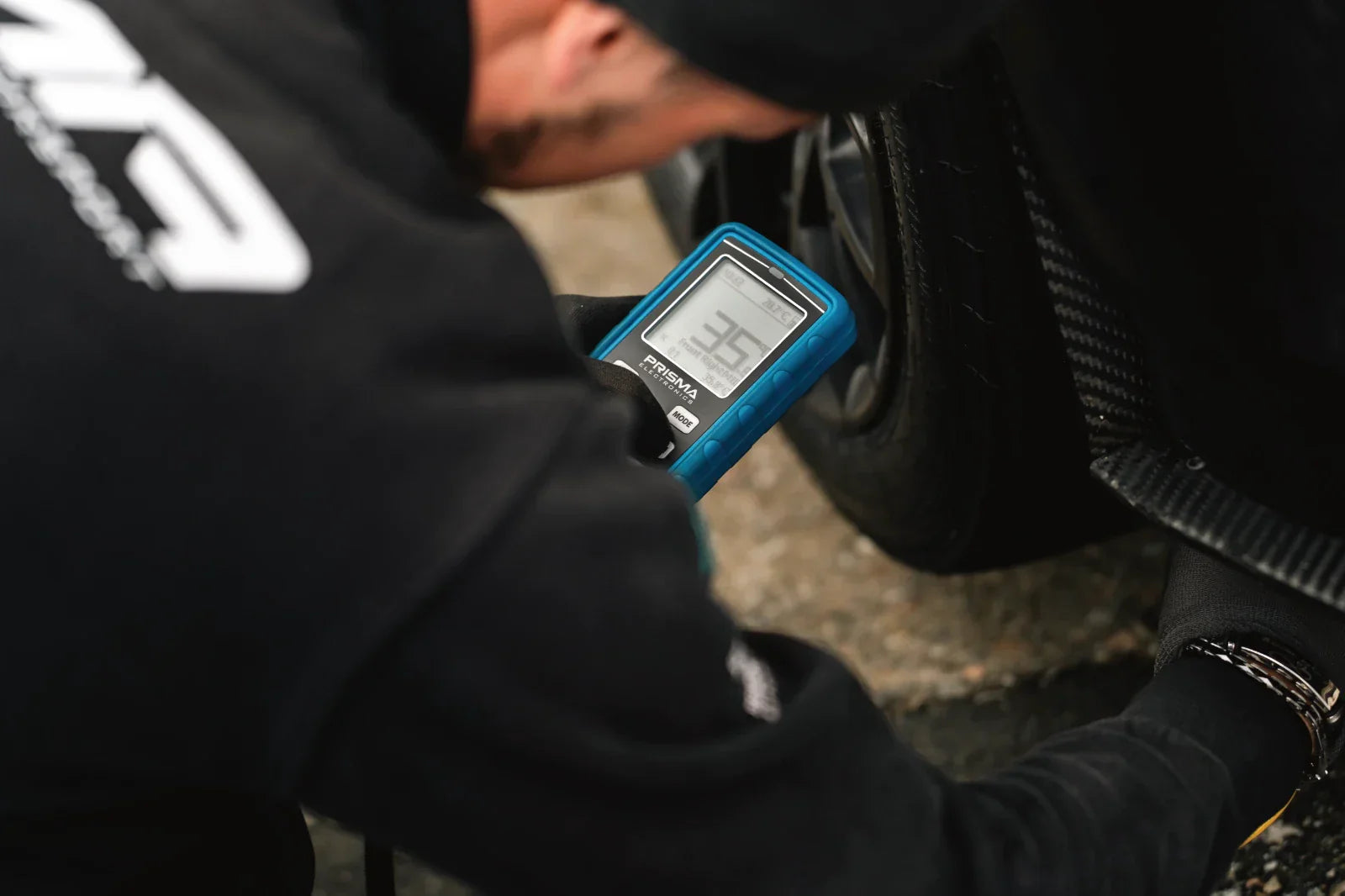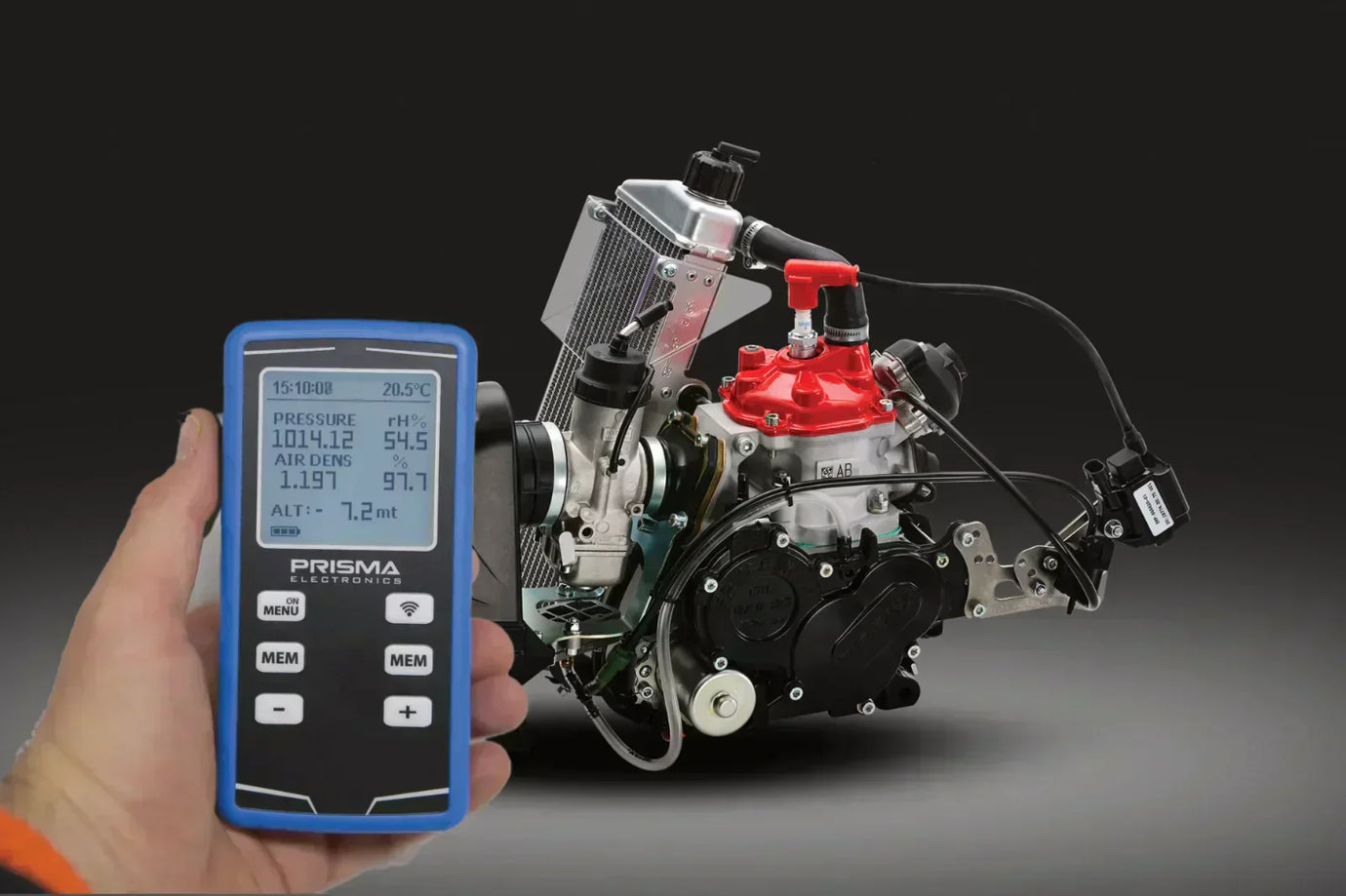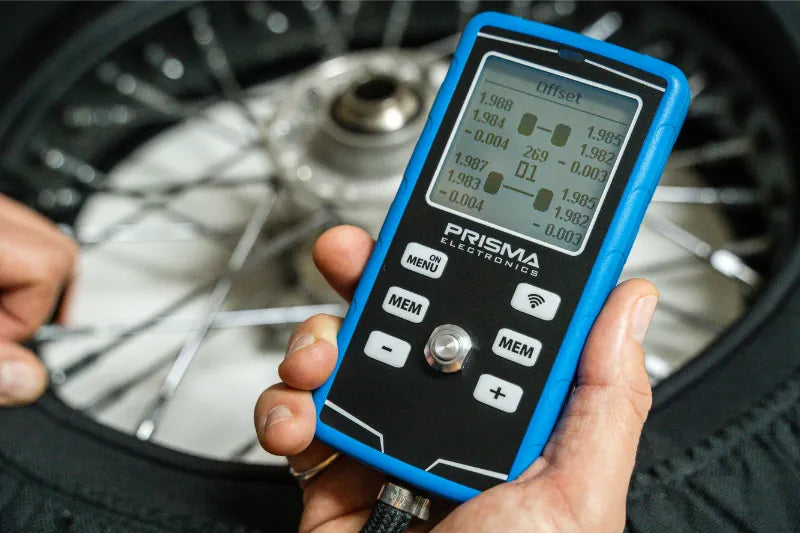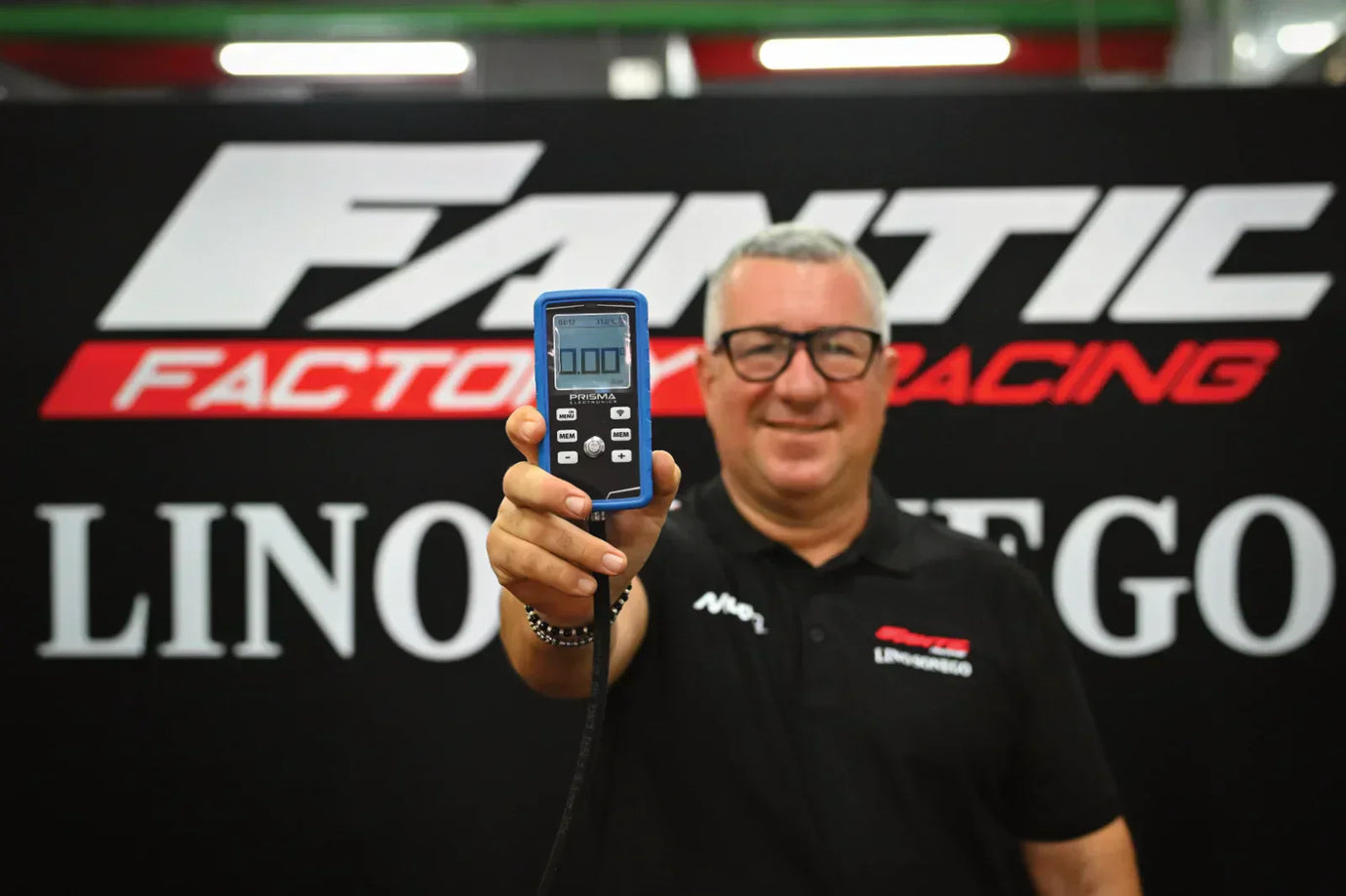Last Update: September 25,2025
How to Measure Tire TEMPERATURE in Motorsport: Infrared Pyrometer vs Needle Probe
Contents:
Infrared Sensor or Needle Probe
How we carried out the Test
Temperature measurement with needle probe
Temperature measurement with Infrared Sensor
Are you sure you're measuring tire temperature correctly?
Tire temperature management is a key element in motorsport that can have a significant impact on vehicle performance. Basically, tires are the only point of contact between the vehicle and the asphalt, so it is obvious that we need to optimize as best we can the energy transfer that is achieved during vehicle motion.

One of the main questions we are often asked is:
Is it more accurate to use an pyrometer with infrared sensor or one with a needle probe?
There is no exact answer. Let’s start with the assumption that the purpose of measuring tire temperature, whether with a probe or infrared sensor, is to evaluate the footprint of the tire on the ground, that is, how energy is distributed between the vehicle and the asphalt.
As soon as the vehicle returns to the pits, this operation must be performed as quickly as possible and also as repeatable as possible . So, it is important that the method must always be the same in order to avoid different data from test to test.
It is interesting to understand what differences there were on the tires and their performance due to set-up variations or different track conditions.


In addition to evaluating the energy distribution on the tread surface, by measuring Temperature we can understand whether the operating range is within the ‘correct range.
Staying within the optimal temperature range enables us to achieve the best mechanical grip and minimize performance degradation (indicated by the yellow zone in the graph).

A further clarification to be made is that when we measure the Temperature as soon as the vehicle has returned to the Pits, we are not measuring its absolute value, that is, its maximum value, but the temperature that is assumed to be the average temperature during its use. This is because the maximum values will occur at heavy braking and its minimum will occur at long straight runs. So what we need first and foremost is a repeatable method that allows us to measure Temperatures as quickly as possible before heat dissipation distorts the measurement.
So we want to compare the measurement with Infrared sensor or by needle probe.

There are several theories, one of which states that the Infrared sensor only measures the Surface Temperature and is therefore incorrect. This is true, the Infrared sensor measures the radiation emitted by a body, in this case the tire, but it is also true to state that the surface temperature is affected by the temperature of the entire compound. Assuming the surface temperature to be, for example, 100.0°C, the immediately lower layer certainly cannot be 90.0°C. Obviously there is a temperature gradient from the air inside and up to the tread surface but this will not be measurable with either the Infrared sensor or the needle probe but only with complex simulations and/or calculations.
Another aspect to consider is that the Infrared sensor must be PERFECTLY calibrated to the wavelength of the tire. An Infrared pyrometer measuring the Temperature of a tire cannot correctly measure the Temperature of a red colored surface (absolutely random example) and vice versa.
Equally, by measuring with the needle probe with a length of 3/5 mm, I will have a measurement of the average compound temperature of that portion of the volume.

Returning to the search for our method of measurement that is fast and repeatable, we realized that we mainly want to measure whether we are within the correct operating temperature and how the Temperature distribution on the tread surface can give us an assessment of its footprint on the ground.
How we carried out the Test
At Prisma Electronics we set out to do two practical tests, both with the needle probe pyrometer and with the infrared sensor. The instrument used is a Digital Tire Pressure Gauge with a Dual Technology Pyrometer, specifically designed to have a choice of which method to use depending on the measurement you want to take.
Two different tires.
1 – Pirelli 13″ ex-Formula 1 tire heated with Thermocover at about 100°C.
2 – Front Supermotard tire with Thermocover about 80°C.
What tests we performed.
Accuracy – Do the measurement with Needle Probe and Infrared Sensor give the same values?
Speed of response – Which of the two methods is faster in measurement?
Below is the video of the Test carried out in the Prisma Electronics
Comparison result: Infrared Pyrometer vs Needle Probe
Accuracy.
Needle probe – 105.1°C
Infrared sensor – 104.8°C
Difference : 0.3°C
Accuracy with Supermoto tire.
Needle probe – 85.0°C
Infrared sensor – 85.3°C
Difference : 0.3°C
Response Speed.
Infrared Sensor – 27°C -> 73.5°C : About 1 Second Maximum
Needle probe – 24°C -> 73.1°C : About 5 Seconds. This is the worst case as the probe was at Room Temperature 24°C. From the second reading, the response speed is about 3 seconds.
The test was also done on a motorcycle tire to point out that although the measurements between probe and Infrared are both accurate, the curved profile definitely favors the needle probe measurement.
So to the question of which is the best instrument to use, already a first answer we can give is that it also depends on the type of tire.
In two-wheelers, where the tire profile is curved, it is certainly easier to use the needle probe.

In the open-wheel categories, measuring with an infrared sensor makes it possible to obtain very fast measurements and thus not be affected by the thermal dissipation that causes temperatures to plummet.
The possibility of having a pyrometer with IR Sensor + Needle Probe has the advantage of being able to quickly select with which of the two you want to make the measurement; if, for example, a tire has obvious signs of blistering or graining, it is very useful to go and measure with the Needle Probe the main points where these effects are accentuated in order to understand the Temperature value.

On the other hand, if the tread surface is homogeneous, with the Infrared Sensor you can get a very quick measurement as soon as the vehicle returns to the Pits.
Having the Digital Gauge with Dual Technology Pyrometer therefore allows you to have the ability to choose by which methodology I want to measure the Tire Temperature also based on how the tread condition is.
As mentioned above, if the vehicle is a motorcycle, it does not make sense to have the Infrared Sensor and therefore it is better to opt directly for the Needle Probe.

Tire Temperature measurement with needle probe
Advantages
- Simply insert the entire needle into the tread and wait for the temperature to stabilize.
- Ability to measure compound temperature at a depth of 3 / 5 mm and at exact points ( e.g. at points with Blistering – Graining ).
Disadvantages
- In order to have the fastest possible measurement, needle probes are very thin and therefore very delicate.
- Relative slowness in measuring Temperatures, about 2.5 / 3 seconds in the best case for each measurement. In case of measuring several points per tire there is a risk of getting to the last tire that has dispersed Temperature.
- Not very accurate in case of Asphalt Temperature measurement. The probe must penetrate the material to be measured in order to reach the measured temperature correctly.
Tire Temperature measurement with Infrared sensor
Advantages
- Extremely fast measurement speed, 0.5 Seconds per measurement. It is possible to measure each tire quickly without running the risk of having dispersed Temperature.
- Very wide temperature range.
- Possibility to measure the average temperature of the tread surface thanks to the FOV. At this link a detailed article on FOV ( MEASURING TIRE TEMPERATURE WITH INFRARED SENSOR )
- Fast and absolutely accurate in measuring asphalt Temperature.
Disadvantages
- Measurement that requires caution. One must properly aim the surface to be measured in front of the IR sensor and at a well known distance according to the point to be measured Read article on FOV at the link above.

- Always keep the IR sensor clean by periodically checking for rubber debris inside.
Which Instrument Should You Choose?
Both infrared pyrometers and needle probes have unique advantages when it comes to measuring tire temperature in motorsport. Infrared sensors are ideal for quick pit stop checks, while needle probes provide a detailed thermal profile of the tire tread during testing. For professional teams and serious racers, combining both methods ensures the most accurate data for optimizing tire performance and race strategy.
With the Prisma Electronics HPM5 Dual Technology Pyrometer, you don’t need to choose: it integrates both Infrared and Needle probe technologies in a single instrument. Designed with and for Motorsport professionals, it guarantees accuracy, reliability, and ease of use directly at the track.
Get ahead on track — explore our full range of digital tire pyrometers .
EFFECTS OF ASPHALT TEMPERATURE ON TIRE DEGRADATION
An important parameter to consider when evaluating the temperature range of tires is the asphalt temperature.
Effects of asphalt temperature on tire degradation.








 PISAM • Online Support
PISAM • Online Support